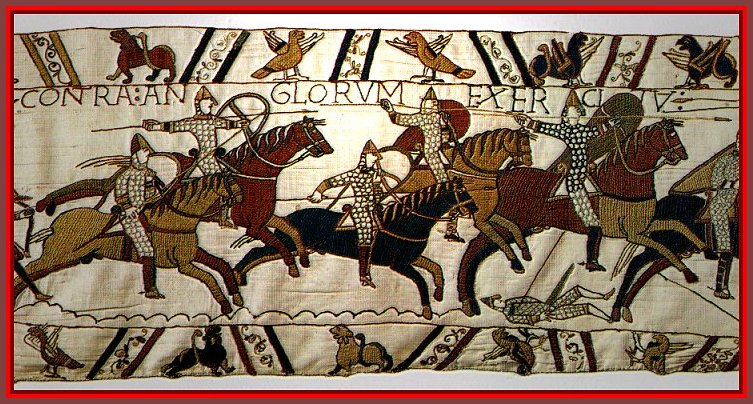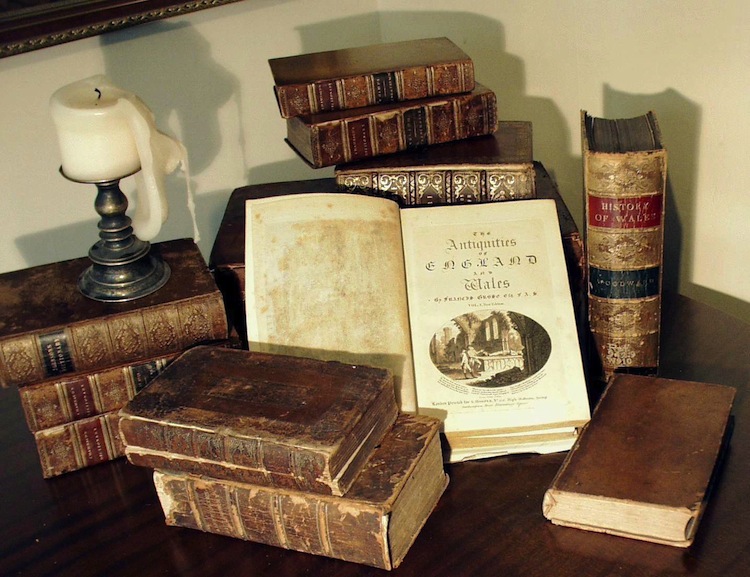The history behind the battle of Hastings and the Norman Conquest began 50 years before William’s army set foot on English soil at Pevensey. It is a story of intrigue, deception and treachery.
Cnut’s takeover
When William, Duke of Normandy defeated Harold Godwinson on the field of Hastings, he was conquering a nation of collaborators.
The story of the Norman Conquest does not start in 1066, but 50 years earlier, with another invasion and another group of Norsemen. In 1016, Cnut, King of Denmark, seized the kingdom of England by exploiting the bitter rivalries between king Aethelred Unraed (without counsel), his son Edmund Ironside and his closest advisors. Cnut’s takeover had not been unexpected: many English magnates had been aligning themselves for just such an eventuality – most important among them being Eadric, ealdorman of Mercia, whose treachery at the Battle of Ashingdon handed Cnut the throne.
…traitors were never trusted but collaboration paid.
Eadric did not get quite the reward he expected. At the Christmas court of 1017, Cnut stunned the English with the murder of ealdorman Eadric, his supporters and every member of Aethelred’s royal family he could get his hands on. Only Edward and his brothers, the younger sons of Aethelred, survived. They fled to Normandy, where they took refuge with Duke Richard II, brother of their mother Emma.
In place of the murdered magnates, Cnut installed his own men, both Danish and English, loyal to himself. The most prominent of these were Earls Leofric and Godwine, who prospered under the new Danish régime. They and their families had learned two valuable lessons from the Danish conquest: traitors were never trusted, but collaboration paid. Cnut also secured his external position by marrying Emma, maintaining a link to the old régime and ensuring that the Duke of Normandy would not come out in favour of the dispossessed Edward.
The Godwines
Edward spent the next 30 years in exile under the protection of his uncle, Duke Richard II and his successors. Whilst there, he made several friends, among them Eustace of Boulogne and the Breton Ralph the Staller. On his return to England in 1042, as Edward the Confessor, he promoted many of these Frenchmen into positions of influence, as a counterbalance to the overweening power of the Godwine family.
…a notorious group called the Frenchmen…
The Godwines had prospered greatly while Edward was away. Under Cnut and his successors, they had amassed so much land that they were second only in power and wealth to that of the King. So when Edward returned after the death of Cnut’s son, Harthacnut, he found his position hamstrung by Cnut’s old Earls. He tried to offset this by allying himself with Earls Leofric and Siward, the enemies of Godwine, and by promoting his own friends, a notorious group called the ‘Frenchmen’ who were made up of the Norman and French nobles with whom Edward had shared his young adulthood.
William of Normandy
Meanwhile, Normandy was embroiled in its own succession crisis. Duke Richard II’s son, Robert, had died in 1035, leaving an 8-year-old bastard son, William as his heir. William’s formative years were immersed in assassination, exile and civil war, from which he emerged in 1047 at the Battle of Val-ès-Dunes as the dominant power in Normandy, with his capital at Rouen, a prosperous trading settlement much like Viking Jorvik (York).
William was a large man, of exceptional strength and appearance. His tomb at St Etienne in Caen was despoiled by Calvinists during the Reformation, but its size and analysis of the one remaining thigh bone show that he was remarkably tall for a medieval man, standing at 5’10”. He had inordinate strength: William of Malmesbury describes how he could draw a bow that no other man could draw, whilst spurring on a horse.
He was also ruthlessly efficient, and thanks to his childhood valued personal loyalty and the unbreakable ties of the family above all else. To this end, he promoted his two half-brothers into key positions. Robert became Count of Mortain and Odo became Bishop of Bayeux. In 1050, he married Matilda, daughter of the Count of Flanders in what seems to have been a genuine love-match. He doted on his wife and trusted her judgement enough in later life to leave her as his regent in Normandy.
Edward the Confessor
…he was aware he might never have children…
Edward, by contrast, was already an old man. He had spent his entire adult life waiting for the chance to be King of England, and having achieved it had found his power circumscribed by the over-powerful subjects of his predecessors, so much so that he was forced to marry Edith, daughter of Godwine, in a marriage of dynastic expediency. The chroniclers say that he despised his wife so much that he never consummated the marriage. Instead, he ‘found God’ throwing himself into pious works, the most enduring of which was the foundation of Westminster Abbey. So by 1051, it is entirely possible that he was aware he might never have children, so long as he remained married to Edith.
In 1051, he acted against the Godwines. The lever he used was a dispute between Eustace of Boulogne and Earl Godwine sparked by an incident at Dover. Eustace, on the orders of the King, tried to take over the town. Godwine resisted, and when he was called to account, chose to flee into exile with his sons rather than face a prejudiced tribunal. Edward immediately put aside Edith, and at the same time, William of Normandy came to visit England.
William gains power
Later Norman chronicles claim that on this visit Edward offered William the crown of England. It is difficult to see why. Edward was in the most powerful position he had achieved since his accession in 1042. He had got rid of the Godwines and his appointees were in all the positions of power. He had also put aside his wife, and no doubt could have found a way round the divorce/annulment problem in one of the many time-honoured traditions.
Yet it can also be argued that knowing whilst he remained married to Edith that he would remain childless, Edward chose to vest the future of the kingdom into the hands of his old friend and protector’s family, which had just proven its fecundity with the birth of William’s son Robert. We will never know. What is certain is that if Edward did offer William the kingdom at this point, it would not be the last time he gave it away. The promise was essentially worthless (though of course we know that William did not wish to view it that way).
…his former allies teamed up against him…
William himself had rather more pressing things on his mind by 1052. He had become so powerful that his former allies had teamed up against him, forcing him to defend his position. However, by 1060, both Henry I of France and Geoffrey of Anjou had died leaving weak successors, and William was poised to expand again. This expansion had a purpose. William was well aware of the vulnerable position of Normandy, surrounded on three sides by enemies, and his actions from 1062 onwards were designed to ensure that Normandy – and the personal patrimony of its dukes – would remain secure.
…he was invading merely to secure his inheritance…
In 1062, he invaded the neighbouring county of Maine. His justification for this is worth noting, for William claimed that Count Hubert of Maine had agreed to marry one of William’s daughters and leave his domain to William if he died without heirs. Hubert is supposed to have named William his heir on his deathbed, and William claimed that he was invading merely to secure his inheritance. This is the first of three times this excuse was used to justify conquest in William’s life: the only time it ever seems to be believed is over England.
The increasing personal power of William is demonstrated by the change in terminology on Norman charters at this time. Norman nobles cease being fidelis (faithful) men, and the duke becomes their dominus (lord). The change is significant. William was now exercising control in Normandy through his own personal patronage, favouring his most powerful friends and supporters. Among these were his childhood friends William fitzOsbern and Roger de Montgomery, who had become his closest and most trusted advisors and confidants, alongside his half-brothers Robert de Mortain and Odo of Bayeux.
Harold
Back in England, the Godwines had returned. They were back by 1052, even more powerful than before, and Edward’s Frenchmen were forced to flee the kingdom. When Godwine died in 1053, his mantle was taken up by his son Harold Godwinson. In 1055, Earl Siward of Northumbria died whilst his son, Waltheof, was too young to succeed him, and Harold manoeuvred his brother Tostig into the earldom. This further strengthened the hold of the Godwine clan on the kingdom. By 1064, it was obvious to all that Edward was going to die without an heir, and Harold must have been weighing up his chances of becoming king.
Harold’s character has been blackened beyond all recognition by the events of 1066. No chronicler could write of him without referring to the role he played in the drama that would lead up to the Norman Conquest. Therefore, he has been portrayed as devious and secretive, an oathbreaker and a chancer. A chancer he undoubtedly was, but then everyone was gambling in 1066.
Harold was clearly courageous, an able warrior and an astute politician. He was able to judge the way the wind was blowing and bend with it, breaking through ancient enmities to form the alliances that were necessary to the realpolitik of his world. He was also handsome and charming, and had an undoubtedly loving relationship with his concubine, Edith Swan-neck. Yet the events during the last two years of his life show that he was also willing to lie and even sacrifice his family on the altar of his ambition.
Harold visits Normandy
Harold visited Normandy in 1064. Why he did this, no-one can be certain. All pro-Norman sources claim that he was sent by Edward to confirm the offer of the crown to William. On the Bayeux Tapestry, he is depicted receiving either orders or a warning from Edward, but since he is undoubtedly being admonished for his ‘failure’ on his return, this can hardly have been instructions to confirm William as king. English sources hint that he was going to France and was shipwrecked on his way, which was why he ended up in Normandy. Sadly, the Anglo-Saxon Chronicle is completely silent on the subject. It has also been suggested that he was visiting William in an effort to negotiate the freeing of his brother, Wulfnoth, who was a hostage in William’s court.
William clearly wanted to overawe Harold.
All we know for certain is that Harold landed in the Norman province of Ponthieu, where he was arrested by Count Guy of Ponthieu. When William heard of his arrival, he sent messengers ordering Count Guy to hand over his prisoner, which was duly done. At this point, William was embarking upon a campaign into Brittany against the new Duke of Brittany, Conan II, and he took Harold with him. William clearly wanted to overawe Harold. He knew that they were both in the running for the crown of England, and he hoped that by taking him on the Brittany campaign he could impress Harold with the futility of opposing Norman interests. However, the plan backfired spectacularly.
The Bayeux Tapestry, in a masterful piece of propaganda, portrays the campaign as a triumph: Conan flees furtively from the town of Dol and surrenders the keys of Dinan to William. However, other sources portray a completely different picture in which William exhausted himself in a futile chase around Brittany and was finally forced to withdraw after he ran out of supplies. The only person to come out well from the whole affair was Harold, who is portrayed on the Bayeux Tapestry rescuing some of William’s men from the quicksands in front of Mont St. Michel. His later actions tend to indicate that he was less than impressed by this demonstration of the inexorable Norman war machine in action.
Oath
HAROLD – HERE GUY HAS SEIZED HAROLD AND HAS TAKEN HIM…
Earl Harold holds a spear in the bow of the ship. And then, bare-legged to wade ashore, he is taken captive by count Guy of Ponthieu. (This is the second of several instances – multiple ships being the first – where the Bayeux Tapestry artists use duplicate images of the same character or object to show action.) Throughout these and the earlier scenes the English have no weapons except Harold’s lone spear: and possibly in this scene, Harold and his two nearest compaions are armed with knives. Harold is already holding his out in front of himself, and the others seem to be depicted in the act of going for their knives, which are sheathed parallel to their belts behind their backs. I have a difficult time with the idea that Harold and his party of companions went across to see duke William of Normandy unarmed. Perhaps the English artists were sending a subtle hint to those who would view the Tapestry that the last “English” king was an innocent victim.
We get our first look at early “heraldry.” All the English shields were blank on the ships. But Guy’s knights sport four fascinating shield patterns (the knights ride casually without armor). The mixing of pagan and Christian motifs is typical of this period. The Normans were only a couple of generations beyond their Scandinavian origins.
The visit ended with Harold swearing his infamous oath to Duke William. This is eloquently described by the Anglo-Norman historian Orderic Vitalis:
‘Harold himself had taken an oath of fealty to Duke William at Rouen in the presence of the Norman nobles, and after becoming his man had sworn on the most sacred relics to carry out all that was required of him. After that, the Duke had taken Harold on an expedition against Conan, Count of Brittany, and had given him splendid arms and horses and heaped other tokens upon him and his companions.’
 In this passage, Orderic highlights the three great bones of contention about the oath: no-one can agree where it was sworn (Rouen? Bonneville? Bayeux?); no-one can agree when it was sworn (before or after the Brittany campaign?); and no-one can agree why it was sworn. Was Harold simply swearing an oath of fealty as a vassal of William, or was there actually something more to it, as the pro-Norman sources would have us believe? This is important, because as a vassal of William’s, Harold was not constrained to hand over the crown of England any more than William, a vassal of the French king, owed the crown to France.
In this passage, Orderic highlights the three great bones of contention about the oath: no-one can agree where it was sworn (Rouen? Bonneville? Bayeux?); no-one can agree when it was sworn (before or after the Brittany campaign?); and no-one can agree why it was sworn. Was Harold simply swearing an oath of fealty as a vassal of William, or was there actually something more to it, as the pro-Norman sources would have us believe? This is important, because as a vassal of William’s, Harold was not constrained to hand over the crown of England any more than William, a vassal of the French king, owed the crown to France.
A close examination of the Bayeux Tapestry tends to suggest that Harold was being honoured after heroics on the Brittany campaign, given arms and armour, and in return swearing an oath of fealty. Even the most pro-Norman sources tend to suggest that there was an element of trickery about the whole occasion: Harold is said to have sworn a hollow oath, after which William whipped away the covering on the table, revealing the most holy of relics which bound it. So it seems likely that Harold did not believe he was swearing away the kingdom, and it was only after the fact that William and his apologists were able to dress this up as the great act of perjury that it became.
Consolidation of power
Still, we should not paint Harold in completely innocent colours. Harold was already thinking like a king by 1064. He was undoubtedly considering his own position vis à vis the throne of England, and like any politician of his age, he would undoubtedly have sworn to anything in order to get himself out of the dangerous position in which he found himself.
…Kings made and broke…vows all the time…
Kings made and broke solemn vows all the time, and it was only when someone else had something to gain from it that they were called to account. Harold needed to get back to England and muster the support he would require to make his bid. In order to do that, he would have sworn away his own brother. In a passage laden with hindsight, the chronicler Eadmer has Edward admonishing Harold on his return: ‘Did I not tell you that I knew William, and your going might bring untold calamity upon this kingdom?’
The proof of this all came in 1065, when the people of Northumbria rebelled against the harsh rule of their new earl, Harold’s brother Tostig. Tostig appealed to Harold and the King for help, but that help was not forthcoming. Edward held no love for Tostig, and Harold had seen a way that he could use his brother’s misfortune to win the backing of the other great power in the land, the family of Leofric. Leofric’s grandson, Edwin, was now the Earl of Mercia and almost as strong as Harold himself; but his brother, Morcar, was yet to have an earldom.
Harold made a deal: he would support Morcar into Northumbria against his own brother Tostig and also against the rightful heir, Waltheof, if the family of Leofric eschewed its old enmity with the Godwines and supported Harold in his bid for the throne. This act of filial treachery was to have significant consequences. Tostig fled into exile, vowing revenge against his brother, and the scene was set for the tragic events of 1066.













